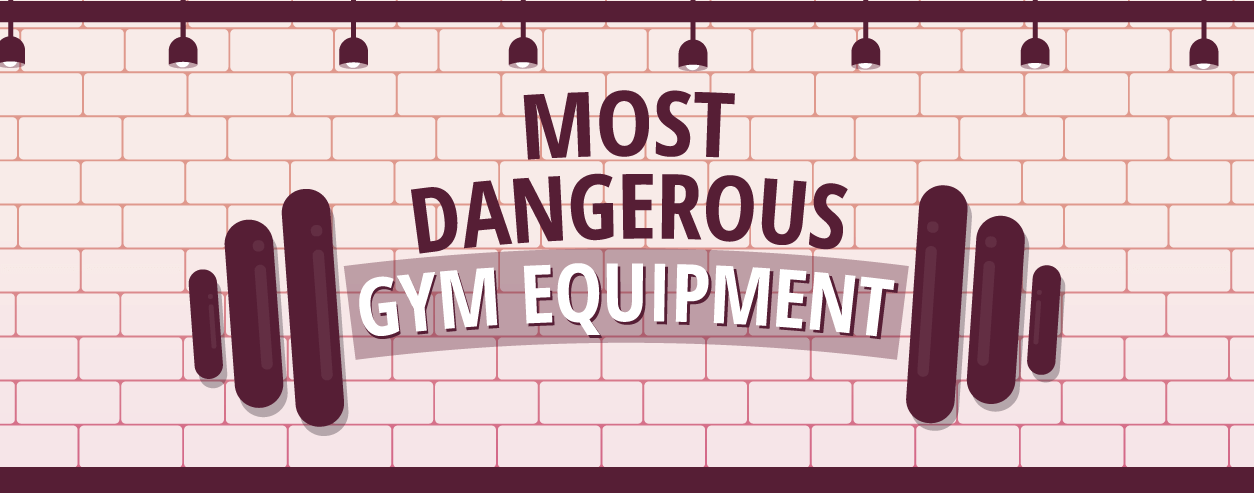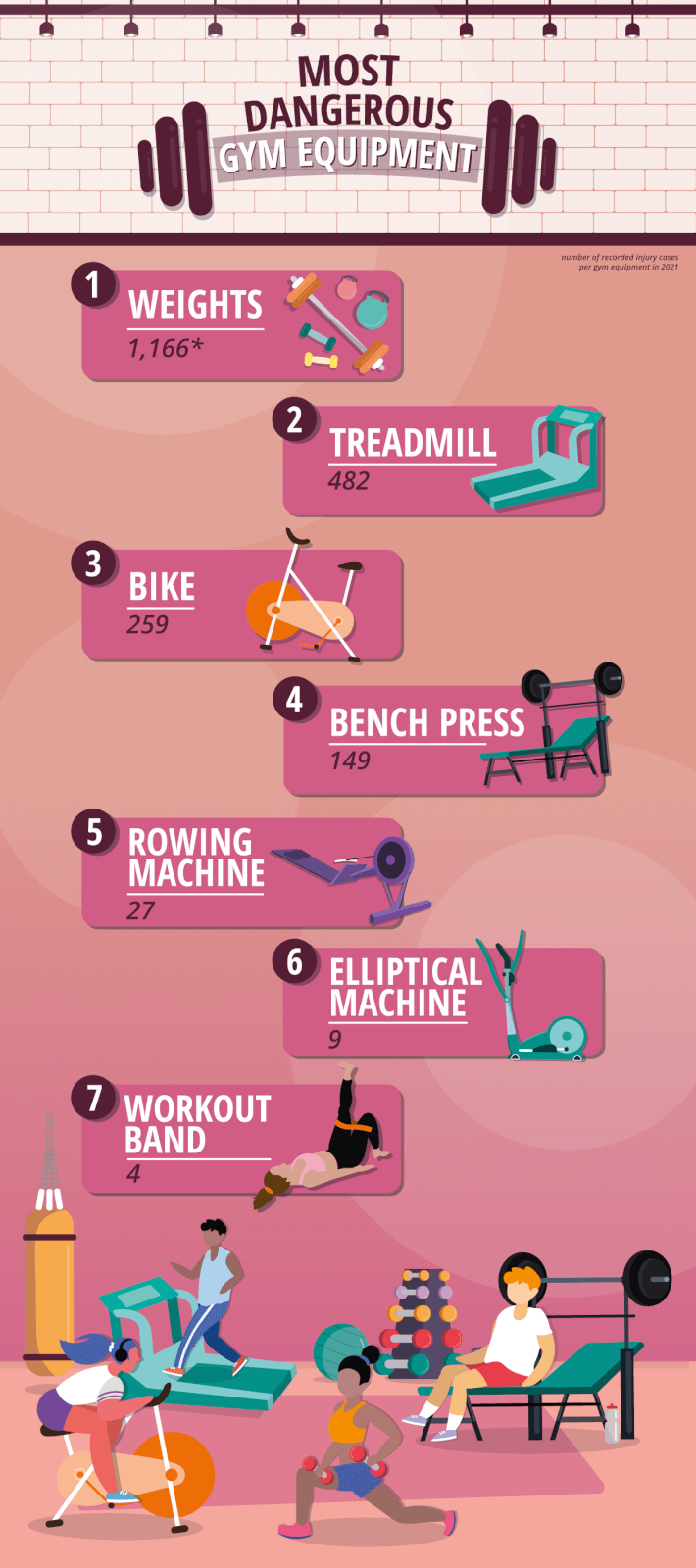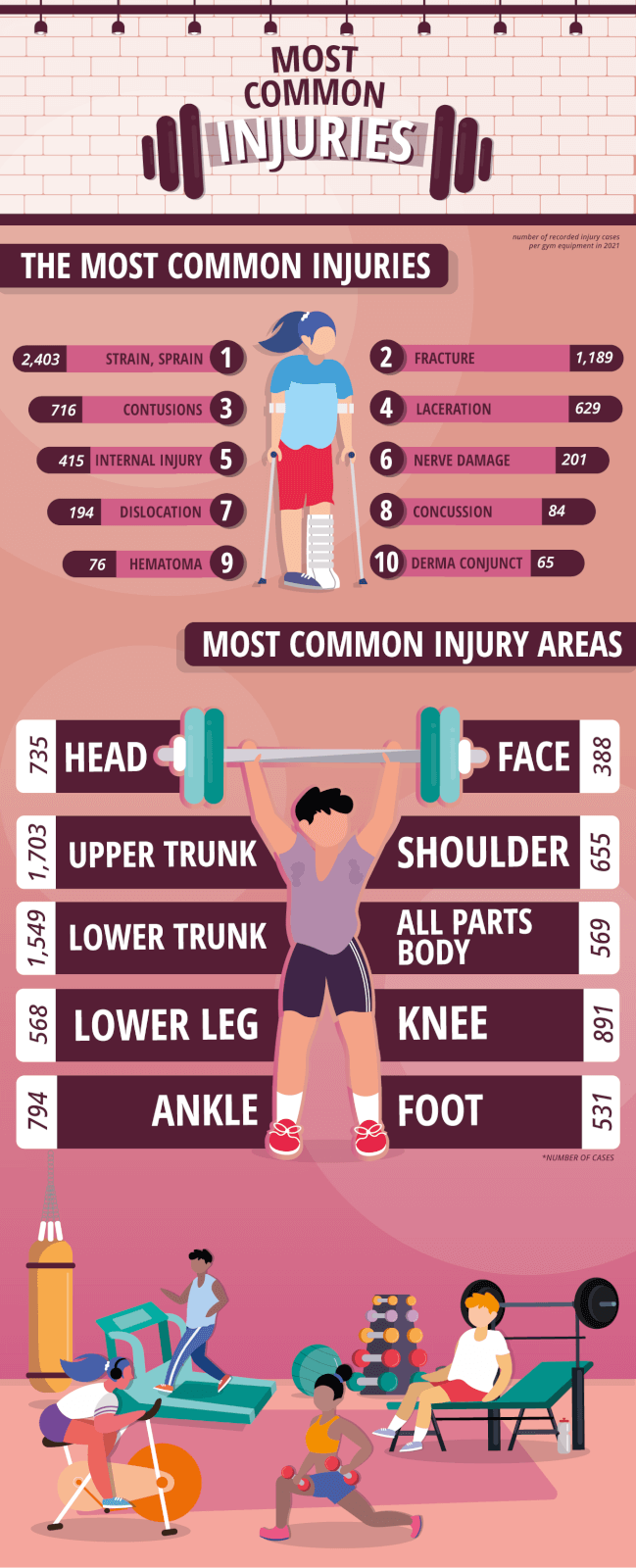The Burrow

For a lot of people, the start of a new year brings the opportunity to get into a better physical shape, and the gym is a great place to start training, with approximately 184.61 million members of a health and fitness club, worldwide.1
However, if you don’t use gym equipment correctly, then instead of getting stronger and fitter, you could cause yourself an injury – some minor, and some more serious. More intense injuries, such as a shoulder or elbow injury from incorrect use of a gym machine, could be serious enough to land you in hospital as an inpatient requiring ongoing care. As experts in health insurance, we recognise the benefits that private health insurance could have in these instances, such as allowing you to choose your own available doctor in the event of required surgery, as well as having your own room in a private hospital (subject to availability).
So, what are some of the most common gym-related injuries? Using data from the US, we were able to determine the number of exercise equipment-related injuries reported in 2021, to see which caused the most injuries, as well as the most common types, and which area of the body is most susceptible to injury.

It goes without saying, that weights are the most dangerous type of equipment you’ll find at the gym, with 1,166 cases of related injury reported. Not only can lifting weights that are too heavy (or holding them incorrectly) cause an injury, but so can dropping them. So, whilst you may want to push yourself, it’s important you don’t try and lift weights that are too heavy.
In second place, with 482 reported cases, is the treadmill. A classic piece of gym equipment, whether you regularly run long-distances on it at high speed or use it for cooling down, for a lot of gym bunnies, the treadmill is a regular part of their workout routine.
However, because the floor of the treadmill doesn’t absorb much impact, prolonged use of it can cause knee and hip pains… not to mention, if you set it too fast, you could fall off and hurt yourself!
The third-most dangerous piece of gym equipment, with 259 cases, is the exercise bike – and again, the source of most injuries on this can be caused by not using it properly. For instance, if you hunch too far forwards over the handles, then you could end up suffering from back and shoulder pain, and if you don’t hold onto the handles correctly, then you could strain your wrists.
Bench presses and rowing machines are in fourth and fifth place, with bench presses capable of damaging your shoulder muscles if not used correctly – and the worst-case scenario being a couple of cracked ribs if you drop it on yourself.
With rowing machines, you could end up with a whole host of pain in your back, knees, and wrists if you don’t have the correct posture while you’re using it.

The biggest type of injury caused is muscle strain, with 2,403 cases. Typically caused by overexertion, if you’ve had a really intense workout, then make sure you rest the day after. Whilst most muscle strains can be minor, and resolve themselves within a few days, sometimes they can be more serious, so make sure you warm up properly, and listen to your body if you feel fatigued.
With 1,189 cases, fractures are the second-most common type of injury, and are commonly caused by dropping a heavy weight, or rolling your ankle on the treadmill or elliptical machine.
Contusions and abrasions are also extremely common injuries, and are caused by falling against a hard surface (for example, if you’ve tripped on the treadmill), or scraping your skin against a surface.
Lacerations (or skin wounds) come in fifth place, followed by internal injuries, which can be extremely serious, and again, often caused if you drop heavy weights on yourself.
On equally serious notes, nerve damage, dislocation, and concussions are also relatively common gym injuries, highlighting just how important it is that you know how to correctly use all of the gym equipment, before giving it a go.
In terms of where you’re most likely to injure yourself, your upper and lower trunks are the two most common areas, at 1,703 and 1,549 cases respectively. If you’re having an arms day at the gym, the muscles in your upper trunk are the ones you should be the most cautious of, as you have a greater chance of causing injury there.
Knees and ankles are the next most common areas for injuries, so make sure you have the correct stance when lifting weights and try not to go too hard on the treadmill.
Interestingly, the head is the fifth-most common area to be injured, with 735 cases. Whilst something extreme like banging your head when falling off a treadmill can be a cause, you can actually get exercise-induced headaches if you’re working out in a poorly ventilated area, so make sure you’ve got a bottle of water on you at all times.
Of course, for most people, a trip to the gym doesn’t result in an injury, but it’s always better to be on the safe side. These tips will help you to reduce your chance of aches, pains, and full-blown injuries.
Whether your preferred form of exercise is long-distance running, a dance class, or lifting weights, you should always make time to both warm up and cool down appropriately. Spending 10 minutes warming up will get your blood flowing and should help you to become more flexible – think light jogging, lunges, and squats.
Cool downs are equally as important, as failing to do so could cause you to strain your muscles – all you need to do is turn down the intensity of your workout. For instance, if you’ve spent 30 minutes running on the treadmill, turn that into a slow jog, followed by a walk.
If you’ve just signed up at a new gym, ask for an induction so that you can have a proper demonstration of how to use all the equipment. If you’re still unsure, it might be worth paying for a couple of personal training sessions, so you can learn the proper form when doing exercises.
Whilst it can be tempting to jump straight in, as you can see, poor posture and incorrect use of machines is the root cause of a lot of injuries.
Sometimes you just don’t feel like exercising, and it’s important to recognise the difference between when you’re feeling lazy, or when your body’s genuinely tired and you feel like you physically can’t handle a workout.
When exercising, pay attention to your body at all times. If you’re lifting weights and find your shoulder’s twinging, then don’t power through, as that could make it worse.
As Anthony Fleming, General Manager of Health Insurance at Compare the Market Australia states: “Whilst that burst of energy you feel just before a workout can leave you wanting to jump straight in, it’s important you know the correct techniques and ways of using the equipment, so you don’t get injured unnecessarily.
“However, sometimes injuries do happen and in some cases, this can land you in public hospital emergency departments. In instances like these, private health insurance can be useful for ongoing care and support. Having a private health insurance policy in place ensures you are prepared for that possibility, so you can spend less time worrying about the expense and more time focusing on a safe and healthy recovery.”
You can use Compare the Market’s free health insurance comparison tool to look for a policy that is most suitable for you and your personal circumstances.
All data was sourced from NEISS.
This dataset shows the number of cases recorded of injuries relating to exercise equipment, in the latest full calendar year that data was available (2021). We have created three tables.
The first table shows the most common type of injuries and has been ranked in terms of the number of cases.
The second table shows the most dangerous equipment and has also been ranked in terms of the number of cases. We did this by finding all cases that included one of the equipment in the notes of the injury.
The third table shows the most commonly injured body part and has been ranked in terms of the number of cases.
All data gathered is correct as of 27/01/23.